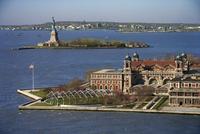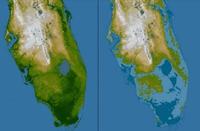-
U.K. to face heavier, more frequent summer downpours, more destructive flash floods
Global warming could cause extreme summer downpours to become several times more frequent in the United Kingdom by 2100, a new study suggests. Its authors say this will likely lead to an increased risk of flash flooding, similar to the Boscastle floods of 2004 and the “Toon Flood” in Newcastle in 2012.
-
-
The Pentagon integrates climate change into military planning
With the release of the National Climate Assessment last month, a clearer picture has emerged of the official policy-related interpretation of climate change data. The debate may still go on amongst civilian branches of government, and between the administration and its critics, the Pentagon, for some time now, has already been integrating climate change-related policies into its daily operations across all branches of the military.
-
-
Sea level rise, not Hurricane Sandy impacts, main cause of subsequent East Coast storm flooding
Flooding in coastal areas bordering Great South Bay, New York, and Barnegat Bay, New Jersey caused by winter storms that occurred following Hurricane Sandy was not influenced by changes Sandy made to barrier islands or other bay features, according to a new U.S. Geological Survey study. “While the existing barrier island and inlet system shield the mainland to a great extent from the daily tides, most of the storm surge, and all long-term changes in water level, such as those resulting from sea level rise, reach the mainland,” say the study’s authors.
-
-
Extreme weather events threaten U.S. national landmarks

Rising seas, floods, and wildfires are threatening the U.S. most cherished historic sites — from Ellis Island to the Everglades, Cape Canaveral to California’s César Chávez National Monument. Scientists say that today these sites face an uncertain future in a world of rising sea levels, more frequent wildfires, increased flooding, and other damaging effects of climate change. At some sites — such as Liberty and Ellis Islands and Cape Hatteras — steps have already been taken to prepare for these growing climate risks. At many other sites, such efforts have not yet begun.
-
-
Canada is not doing enough to prepare for, cope with natural, man-made disasters
The 2013 Alberta floods cost more than $6 billion, making it the worst weather disaster in Canada’s history. Before 1990, only three Canadian disasters exceeded $500 million, but in the past ten years alone nine disasters have exceeded that amount. Disaster management experts said that while it may be understandable that corporate and municipal budgets for disaster training and preparations have been reduced during the economic slowdown, corporate and government leaders in Canada must consider how such reductions would impact the ability of communities to build adequately resilience systems against potential natural and manmade disasters.
-
-
Rising sea levels will be too much, too fast for Florida

The U.S. National Oceanic and Atmospheric Administration (NOAA) published its assessment of sea level rise in 2012 as part of the National Climate Assessment. Including estimates based on limited and maximum melt of the Greenland and Antarctic ice sheets, it anticipated a raise of 4.1 to 6.6ft (1.25 to 2m) by 2100, reaching 2ft (0.6m) by around 2050 and 3ft (0.9m) by around 2075. This means that by the middle of this century most of the barrier islands of south Florida and the world will be abandoned and the people relocated, while low areas such as Sweetwater and Hialeah bordering the Everglades will be frequently flooded and increasingly difficult places to live. Florida will start to lose its freshwater resources, its infrastructure will begin to fail, and the risk of catastrophic storm surges and hurricane flooding will increase. Florida counties should be planning for their future to determine at what point the costs of maintaining functional infrastructure, insurance, and human health and safety becomes economically impossible. Already, there are areas and properties that will become unlivable within a 30-year mortgage cycle.
-
-
Guard fired for Y-12 breach says he was made a scapegoat for contractor’s failings
Kirk Garland, a security guard at the Y-12 National Security Complex in Oak Ridge, Tennessee, was fired from his job two weeks after three aging peace activists, led by an 82-year old nun, managed, on 28 July 2012, to breach the facility’s supposedly impregnable perimeter security systems, then loiter, unnoticed, on the grounds of the facility, where bomb grade uranium is stored. The activists had enough time to spray-paint peace messages and Bible verses on walls, slosh the walls with human blood, and wrap one of the buildings with crime-scene tape. In an arbitration hearing, Garland argued that he was made a scapegoat for the larger failings of the then-security contractor,Wackenhut Services.
-
-
Future cyberattacks to cause more trouble than Heartbleed
Many of the future cyberattacks could take advantage of vulnerabilities similar to Heartbleed, a major Internet security flaw which allows attackers to gain access to encrypted passwords, credit card details, and other data on trusted Web sites including Facebook, Gmail, Instagram, and Pinterest. A new report said that hackers could soon use similar holes in computer security to shut down energy grids, disrupt public services, and steal vast amounts of private data worth billions of dollars, unless institutions take measures today to ready themselves against future Heartbleed-like threats.
-
-
Port security technologies demonstrated in Gothenburg, Sweden
FOI, the Swedish Defense Research Agency, conducted a demonstration in Gothenburg of technology designed to improve the security of ports around the world. One of the reasons for the research into countering intrusion is that many ports find that they lack good and affordable tools for seaward surveillance, and so find it difficult to guard against terrorist attack and organized crime such as theft, smuggling, and stowaways. FOI has, therefore, created a system that is capable of detecting divers, swimmers, or small craft which might attempt to approach the quayside or a vessel tied up alongside.
-
-
Testing distributed computing to protect against cyberattacks on power grids
The power grid is complicated, divided up into sections that cover everything from a single municipal area (like New York City) to large regions (like the entire state of California). Each of these sections is controlled by a single control center. If that control center stops functioning, because of a cyberattack or for any other reason, it is no longer capable of monitoring and maintaining the grid, resulting in severe instabilities in the system. The SmartAmerica Challenge, which kicked off in late 2013 to highlight U.S. research in the field of cyberphysical systems, aims to address power grid security concerns.
-
-
Researchers crack supposedly impregnable encryption algorithm in two hours
Without cryptography, no one would dare to type their credit card number on the Internet. Security systems developed to protect the communication privacy between the seller and the buyer are the prime targets for hackers of all kinds, hence making it necessary for encryption algorithms to be regularly strengthened. A protocol based on “discrete logarithms,” deemed as one of the candidates for the Internet’s future security systems, was decrypted by École polytechnique fédérale de Lausann (EPFL) researchers. Allegedly tamper-proof, it could only stand up to the school machines’ decryption attempts for two hours.
-
-
The next Bay Area’s Big One may be a cluster of major quakes
A cluster of closely timed earthquakes over 100 years in the seventeenth and eighteenth centuries released as much accumulated stress on San Francisco Bay Area’s major faults as the Great 1906 San Francisco earthquake, suggesting two possible scenarios for the next “Big One” for the region, according to new research. “The plates are moving,” the study’s co-author said. “The stress is re-accumulating, and all of these faults have to catch up. How are they going to catch up?”
-
-
NIST seeking comments on revisions to ICS security guide
The National Institute of Standards and Technology (NIST) has issued for public review and comment a proposed major update to its Guide to Industrial Control Systems (ICS) Security. The NIST guide, downloaded more than 2.5 million times since its initial release in 2006, advises on how to reduce the vulnerability of computer-controlled industrial systems used by industrial plants, public utilities and other major infrastructure operations to malicious attacks, equipment failures, errors, inadequate malware protection and other software-related threats.
-
-
Critics say $265 billion transportation bill insufficient
Transportation advocates criticize the lack of an increase in funding in the Senate’s $265 billion surface transportation bill recently unveiled. Senate leaders said the bill would replace the current transportation funding measure and maintain current funding levels, adjusted for inflation, for the next six years. The proposed bill includes $44 billion annually for road and transit projects, based on a Congressional Budget Office(CBO) estimate of how much funding will be needed to maintain current federal transit programs. The CBC has projected that Department of Transportation’s Highway Trust Fund will run out of money by August 2014 without congressional action.
-
-
Coral reefs offer valuable protection for coastal infrastructure
Growing natural hazards from coastal storms, flooding, and rising sea levels are leading to major investments worldwide in coastal defense structures such as seawalls and breakwaters. A new study shows that coral reefs can provide risk reduction benefits comparable to artificial defenses, and reef restoration and enhancement is a cost-effective alternative to manmade structures. Restoring coral reefs as a way to protect coastal infrastructure is also cheaper: the typical price for a tropical breakwater project is $197 million, compared with $129 million for restoring a reef.
-
- All
- Regional
- Water
- Biometrics
- Borders/Immig
- Business
- Cybersecurity
- Detection
- Disasters
- Government
- Infrastructure
- International
- Public health
- Public Safety
- Communication interoperabillity
- Emergency services
- Emergency medical services
- Fire
- First response
- IEDs
- Law Enforcement
- Law Enforcement Technology
- Military technology
- Nonlethal weapons
- Nuclear weapons
- Personal protection equipment
- Police
- Notification /alert systems
- Situational awareness
- Weapons systems
- Sci-Tech
- Sector Reports
- Surveillance
- Transportation
Advertising & Marketing: advertise@newswirepubs.com
Editorial: editor@newswirepubs.com
General: info@newswirepubs.com
2010-2011 © News Wire Publications, LLC News Wire Publications, LLC
220 Old Country Road | Suite 200 | Mineola | New York | 11501
Permissions and Policies
Editorial: editor@newswirepubs.com
General: info@newswirepubs.com
2010-2011 © News Wire Publications, LLC News Wire Publications, LLC
220 Old Country Road | Suite 200 | Mineola | New York | 11501
Permissions and Policies
